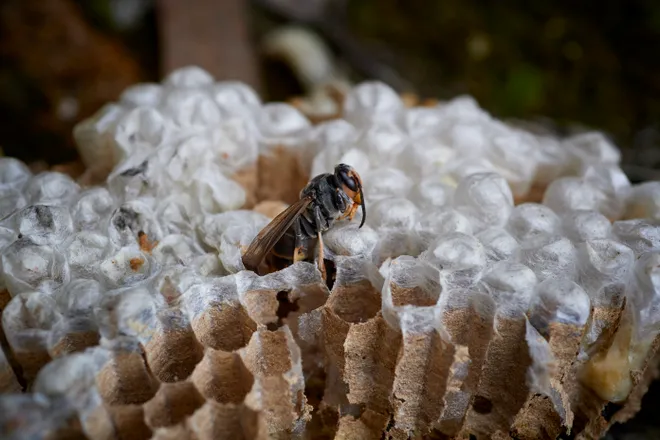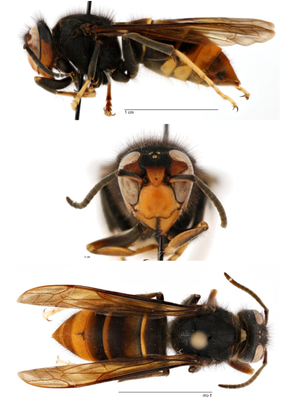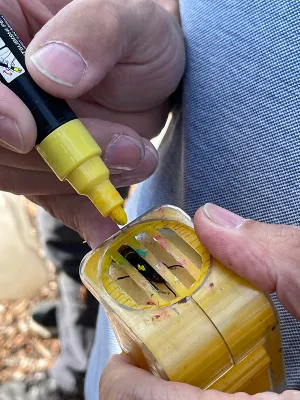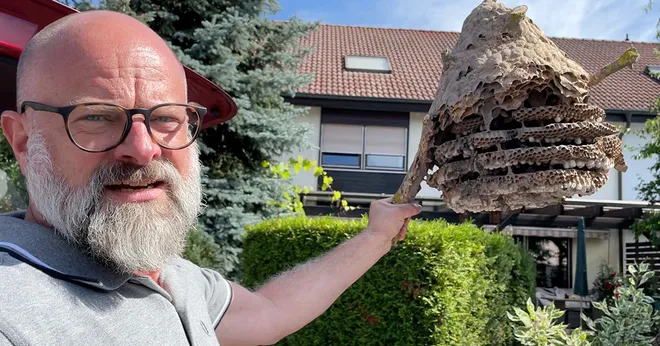New to US: Hornets that butcher bees and sting people. Humans are fighting back.
This story was produced by Knowable Magazine.
In August 2023, a beekeeper near the port of Savannah, Georgia, noticed that something odd was hunting his honeybees. Black with bright yellow legs, the flying insect would hover at the hive entrance, capture a flying honeybee and butcher it before darting off with the bee’s thorax, the meatiest bit.
“He’d only been keeping bees since March … but he knew enough to know that something wasn’t right,” said Lewis Bartlett, an ecologist at the University of Georgia, who helped investigate. Bartlett had seen these honeybee hunters before, during his PhD studies in England a decade earlier. The dreaded yellow-legged hornet had arrived in North America.
Naturally occurring from Afghanistan to eastern China and Indonesia, the yellow-legged hornet, Vespa velutina, has expanded during the last two decades into South Korea, Japan and Europe. When the hornet invades new territory, it preys on honeybees, bumblebees and other insects. One yellow-legged hornet can kill dozens of honeybees in a single day. It can also decimate colonies through intimidation alone by deterring honeybees from foraging.

The yellow-legged hornet is so destructive that it was the first insect to land on the European Union’s blacklist of invasive species. In Portugal, honey production in some regions has slumped by more than 35% since the hornet’s arrival. French beekeepers have reported losses of 30% to 80% of colonies in some locales, costing the economy an estimated $33 million annually.
Background:Invasive yellow-legged hornet spotted in US
All that destruction may be linked to a single, mated queen that arrived at the port of Bordeaux, France, in a shipment of bonsai pots from China before 2004. During her first spring, she established a nest, reared workers and laid eggs.
By fall, hundreds of new mated queens likely exited and found overwintering sites, restarting the cycle in the spring. The hornet’s fortitude allowed it to surge across France’s borders into Spain, Portugal, Italy, Belgium, Germany, the Netherlands, the United Kingdom and Switzerland in only two decades, hurtling onward by as much as 60 miles a year.
Suspected stowaway
As the hornet fanned out across Europe, scientists in North America wondered when it might arrive on their side of the Atlantic. Queens sometimes overwinter in crates and containers, allowing them to stow away on ships. In 2013, researchers cautioned that a yellow-legged hornet invasion at any one point along the East Coast had the potential to spread across the country.
After the first sighting last summer, Georgia’s agricultural commissioner urged people to report hornets and nests, and warned that the insect could threaten the state’s $73-billion agriculture industry.
American farmers grow more than 100 different crops that depend on pollinators. Georgia mass-produces honeybees and ships them north to jumpstart spring crops, like Maine blueberries, before local pollinators have awakened.

Within two weeks, scientists found a nest in a tree, about 80 feet off the ground. In a night-operation, while the hornets idled, a tree surgeon climbed to the nest, sprayed it with insecticide, and cut it down. At a press conference, Georgia Department of Agriculture staff displayed a chunk of the nest about the size of a human torso, warning that this was only about a quarter of the full nest and larger than those seen in Europe.
“Savannah, Georgia, is primo climate for these guys,” says honeybee researcher Gard Otis of the University of Guelph. It’s a lush, subtropical paradise, giving the insect a long growing season — and a rich hunting ground.
For the next several months, Bartlett aided the state agricultural researchers in setting traps and following individual hornets to find other nests. By the end of 2023, they’d removed four more. “We think we’ve discovered them at a very early stage, which is why pursuing eradication is very, very plausible,” Bartlett said in November. If not, Georgia and its neighbors could get caught in an endless — and costly — game of whack-a-mole.
Formidable predator
The yellow-legged hornet and other social wasps, like the common yellowjacket, the German yellowjacket and the western yellowjacket, have successfully invaded every continent except Antarctica. They’ve been introduced to new areas by global trade, sometimes repeatedly.

Social wasps live in colonies of individuals organized into groups that divvy up the labor of reproduction, foraging and caregiving. These behaviors, and the insects’ nearly omnivorous appetites, make them among the most successful invaders of new habitats and fiercest aggressors of native fauna.
In their endemic ranges, these wasps are eaten by skunks, squirrels or bears, or snagged in flight by kingbirds and tanagers. But in the absence of predators, their toll can be enormous.
In New Zealand’s Nelson Lakes National Park, the beech forests are thick with invasive yellowjackets by early autumn. They sip the sugary secretions produced by scale insects living on the trees, and will fight the bellbirds, tui, silvereyes and other birds for it, even slaughtering nest-bound chicks. The densities of their nests — up to 40 nests per hectare and 370 wasps per square-meter of tree trunk — are among the world’s highest.
“When you walk through the forest, you should smell the sweetness of the honeydew and hear the birds,” says biologist Phil Lester of Te Herenga Waka – Victoria University of Wellington, who wrote about management strategies for invasive social wasps in the Annual Review of Entomology. “But with the wasp, you don’t hear the birdsong, you don’t smell the honeydew.”
“They eat everything,” says ecologist Erin Wilson-Rankin of the University of California, Riverside, who has studied invasive social wasps for nearly 20 years. “They don’t specialize. They’ll eat caterpillars, aphids, flies, the whole gamut of arthropods.”

People have tried just about everything to get rid of wasps: fire, boiling water, electricity, traps, poison and brute force. While many poisons do work, they can also harm native insects and other animals. New Zealand has suppressed yellowjacket populations in highly trafficked areas with a selective poison bait called Vespex, but they reinvade elsewhere. Recently, scientists there began an effort to control wasp numbers by releasing a predator: European hoverflies that parasitize the wasp nests. Other scientists are studying the wasps’ genes to identify other solutions.
Nest destruction can kill hundreds of wasps at once, but it’s dangerous: Yellowjackets can squirt venom into an attacker’s eyes, and stings can be painful or life-threatening. Reiner Jahn, a research assistant for a landscape conservation association and a hornet-buster in Germany, describes the pain of a yellow-legged hornet as “digging a hot rusty knife into your flesh.”
Nest busting
On a hot afternoon in September, Jahn pulls up to a school in Viernheim, an industrial town east of the Rhine River. Kids run and jump in the playground, until a teacher ushers them away. High in a tree overhanging the soccer field is a caramel-colored, beach-ball-sized, yellow-legged hornet’s nest.
A whiff of revenge hangs in the air as Jahn and his crew set up. Each is a beekeeper who has suffered honeybee colony losses from yellow-legged hornets, or knows someone who has. Jahn extends a telescopic pole fitted with a spray nozzle toward the nest. He jabs it and blows in a fine powder called diatomaceous earth as chunks of the nest tumble to the ground. Hornets stream out like air from a punctured balloon.

Dusted with the white powder and unable to fly, the inch-long yellow-legged hornets wander through the grass and across the tarp. The crew picks through the nest debris. When a nest is attacked — whether by a predator or a human — the queen may escape, Jahn explains. Find her, and the work is done. This time, she’s unaccounted for.
The trick to stopping a yellow-legged hornet invasion is to wreck the nests before hundreds of new queens fly out in the fall to establish their own nests. In 2023, Jahn destroyed 160 yellow-legged hornet’s nests in his home state of Hesse and 80 in a neighboring state. After a few years of nest-busting, he no longer believes that the yellow-legged hornet can be eradicated in Germany — the country may have waited too long to start removing nests. By mid-May, he’d already fielded calls for 19 new nests, compared with only two by the end of May last year.
Back in Georgia, Bartlett has tracked down the source of the captured yellow-legged hornets. His genetic analysis shows that a single queen arrived from southern China, South Korea or Japan in late 2022. He believes the hornets found last year were the first American-born generation from the stowaway queen. Now, the second-generation has emerged. “We have been finding queens a little further out than we had hoped. But nothing near the distances they see in Europe,” says Bartlett. As of the end of April, the state had trapped and destroyed 21 queens.
Bartlett sees the work as his duty to protect the beekeeping industry, but his hope is that the hornet won’t define his scientific career. Still, Bartlett knows he can’t relent. “If we don’t get rid of them, there is very little chance that I’m not going to become the yellow-legged hornet expert in the U.S.”
This story was produced by Knowable Magazine, an independent journalistic endeavor from Annual Reviews. Sign up for the newsletter.
Disclaimer: The copyright of this article belongs to the original author. Reposting this article is solely for the purpose of information dissemination and does not constitute any investment advice. If there is any infringement, please contact us immediately. We will make corrections or deletions as necessary. Thank you.






